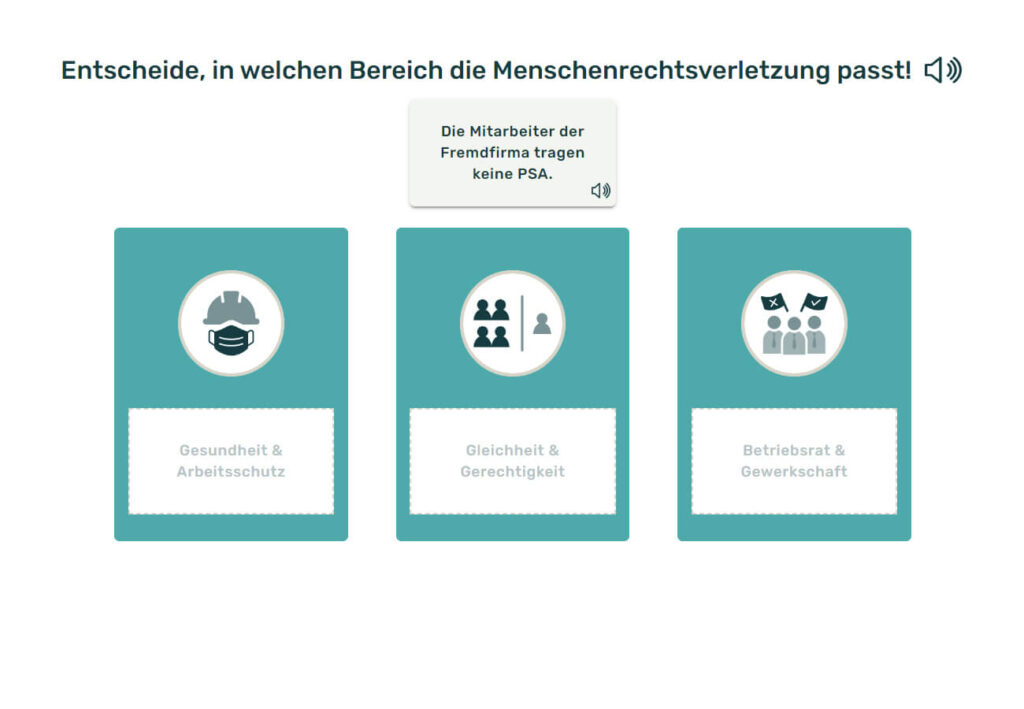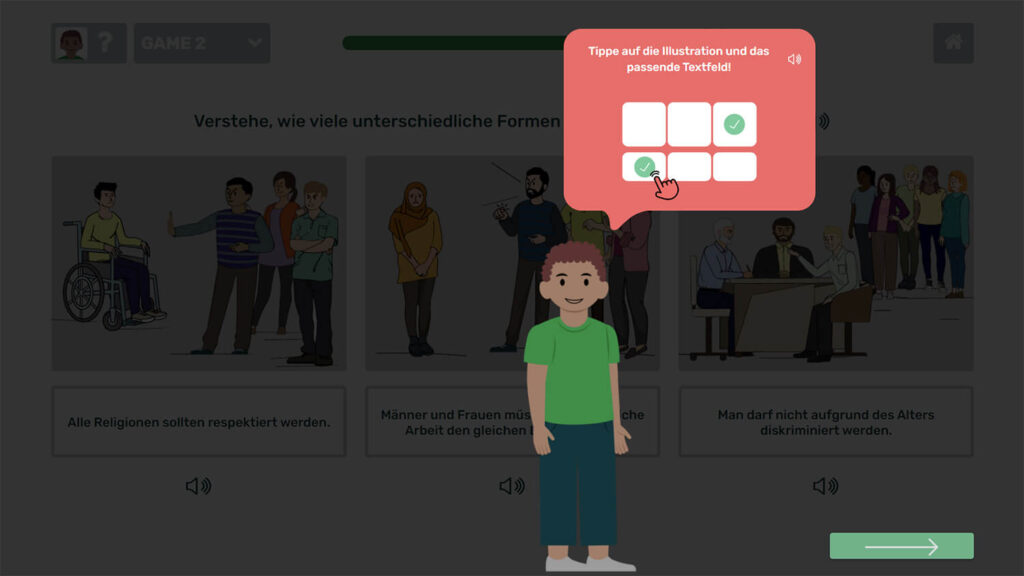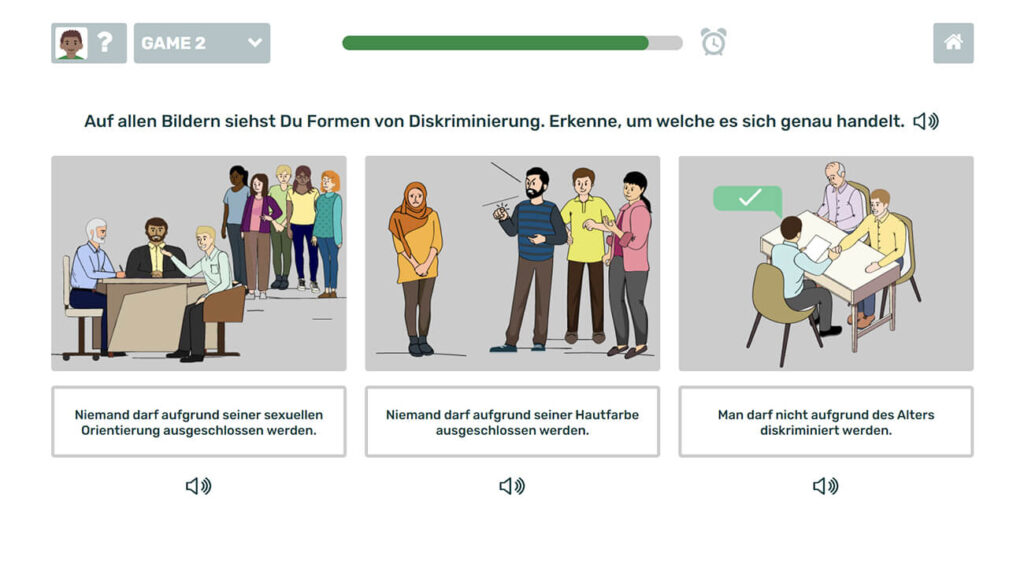Launch of our new course “Human Rights & Grievance Management” for production in the Global North!

So far, our users have only been in production sites in the supply chain – now we have developed a digital human rights training of 4-6 weeks for Europe (Tier 0).
The majority of our users work in factories in China, Bangladesh, India and Pakistan. We have specifically developed our courses for learning in production environments, using simple language and offering a read-aloud function. We provide a clear learning path, many pictures and few words. Thanks to these microlearning measures on topics posing a high risk of non-compliance, our users quickly gain an understanding of the relevant content.
In response to the German Supply Chain Due Diligence Act (LkSG), we received a growing number of inquiries asking whether we could develop human rights training for production employees in Europe as we do for Asia, with an individual login and training certificate, using exercises that also have an element of fun. That’s because a certain amount of fatigue has now set in at German production sites when it comes to digital training. Conventional eLearning with lots of text and multiple choice questions is often perceived as a tiresome interruption, something employees just want to get out of the way quickly. In our initial interviews with shift supervisors and skilled workers, we heard phrases like, “What people learn doesn’t really matter, the main thing is that you can prove it was done, so you won’t be held liable,” or, “We don’t read the texts, we just answer the questions at the end, and to speed things up, we have colleagues rapidly dictate the answers to us.” Our approach of “gamified microlearning” (reducing learning content to the essentials and packaging it into small learning units) is not only a “beyond auditing” solution (moves away from spot checks towards collaboration with suppliers and joint capacity building), but also a “beyond eLearning” solution (once again, a further development of learning approaches designed for Western office environments).
As specialists for foreign factories in the supply chain, we were initially hesitant about venturing into Tier 0, with all the new requirements that would come our way. Not only the new demands of a different target group, but also technical requirements in terms of server structures and GDPR compliance. We decided to expand our offering to include another (Western) cultural group because we are committed to sustainable education – whether that takes place in China or Germany is of secondary importance. In April 2022 we began product development, based on design thinking and agile project management, and after seven months of hard work we are happy to announce the launch of our new course “Human Rights & Grievance Management”!
We take a risk-based approach
Section 6 of the German Supply Chain Due Diligence Act (LkSG) also requires preventive measures in the form of training in the relevant areas of business. Based on our core competence, we focus on employees working in production (blue collar) and we design for industrial learning environments.
When developing a human rights eLearning course for Europe, we felt it was important to focus on topics that are understandable and applicable to employees in production. Employees in the HR department or in procurement need training in different topics than those in production. For example, even though human rights include the right to a clean environment, it is sufficient for employees to understand how ecology relates to human rights. They do not need to absorb specific knowledge such as the Minamata, Stockholm or Basel conventions.
In other words, the learning content is entirely relevant to the target group and pertains to topics that also pose a significant risk of human rights violations in Europe. For the production workforce, it is important to understand what human rights are, when they are being violated, and how to deal such violations.

Our eLearning for human rights focuses on anti-discrimination
Therefore, after analysing the full range of human rights issues, we decided to focus on anti-discrimination in our human rights training. However, we also cover other topics concerning workers’ rights and obligations. In part, we address human rights violations that are ideally not part of the professional landscape in Germany (at least today). Still, it is important to stress that there are always isolated cases to tackle, even when these are exceptional. Human rights training is primarily a preventive measure, so it’s crucial to also address grievances that may seem, at first glance, very far removed from people’s experiences in the workplace.
In the field of human rights, we had to use slightly more text than in our courses for occupational health and safety
Since our aim is to minimise the text that users have to absorb, we worked a lot with photos and illustrations in our courses on occupational health and safety. While this is still a key component of our approach in the Human Rights & Grievance Management course, we had to use a little more text here because a number of topics are particularly difficult to present in visual form. Keen to genuinely reflect the reality of our users’ lives, we returned to these texts numerous times to adjust the tone and choice of words.
Now, looking at the finished product, everything seems perfectly logical. But there were many issues that were discussed and revised over and over. In some cases, it became clear that there was no right or wrong answer, but in the end an editorial choice had to be made.

Instead of a progress bar, we use a timeline to show how much time has elapsed in a training unit
A progress bar serves a so-called “experience category”, namely “noticing progress”. Designing with such categories in mind leads to positive user experiences. Especially when employees are receiving training during working hours, it is important for employers in the industrial environment to be able to plan exactly how long their team members will be absent from production, i.e. unavailable for their usual tasks.
We therefore came up with a “time bar”. It serves as a visual time limit for learners in case they become fully engrossed in the games. It also places an emphasis not on greater speed (the faster I get through a learning unit, the better), but on deep engagement with the content.

Many aspects were different in product development for Germany than for the supply chain in the Global South – a small insight into our challenges
There are fewer unskilled workers in production in Germany
In the Global South, the majority of workers are unskilled. Education does not depend on a person’s intelligence, but on their parents’ financial situation. In the context of German industry, on the other hand, production workers are often technical experts with an intermediate or high level of education, and they are predominantly male. This aspect posed some interesting questions for us: up to now, we offered a choice of six avatars for each culture version, three being male and three female. However, the gender distribution in production in Germany is between 80% and 99% male. So should we offer four male avatars and only two female? In the end, we decided to maintain an equal distribution, partly in order to signal equal opportunities to the (few) female users.
Users in Germany are accustomed to conventional eLearning
While workers in Asia have never received individual training, employees in Germany are often weary of a constant stream of instruction and training. That means their frustration tolerance is lower, and they are somewhat less open at the beginning. In other ways, users in Asia and in Germany have a similar experience: less reading, more interactivity and more gamification leads to more enjoyment!
We decided for a compromise in using gender-neutral language
The topic of gendered language also needs to be discussed in Germany and adapted to the corporate context. In the end, we decided against a policy of applying consistently gender-neutral wording due to a risk of being met with ridicule by the target group. There is probably no right or wrong answer to this issue, and we may have to respond to further social developments in the future. We decided to add variation with the examples, using some female and some male forms. In this way, we reflect gender diversity without modifying the language as a whole. As a result, we do not endanger the acceptance of the course and we still live up to our standard of gender equality.
Without language barriers, getting direct and honest user feedback is much easier
During our product tests in Asia, it was often difficult to obtain critical feedback. Honest feedback requires trust that criticism will not bring negative consequences as well as the ability to verbalise thoughts and feelings. When users have NGO representatives, translators and German product developers sitting next to them, user testing becomes a challenge. This task was much easier in Germany, in a trusting 1:1 environment. Here we were able to gain a lot of valuable input by having users “think aloud” and then integrate this feedback directly in a process of agile product development.
The works council is an important stakeholder in Germany – in Asia, by contrast, we had to actively demand co-determination for our digital human rights training
Especially when it comes to protecting personal data, having users remain anonymous or pseudonymous would actually make many things easier. Works councils want to protect employees from negative consequences if, for example, training results are less than satisfactory. On the other hand, employers are also keen to document the successful outcome of our human rights training, for example, and to know which employees have actually completed all the training units. After in-depth discussions with data protection officers and works councils, we decided that, although no final results will be made public, a list would be provided with the names of employees who have or have not completed all four training sessions. This is the only way to measure whether the learning goals have been achieved throughout the company.
Human rights training is designed to raise awareness rather than to generate factual knowledge. One’s own viewpoints should be reflected and, if necessary, adjusted. Nevertheless, HR or compliance departments also need verification of training outcomes or participation, which means anonymity cannot be granted in every instance.
We do not use all caps
One additional change is that we used to put feedback in all capital letters (WELL DONE!), but ultimately we have opted to use the standard rules for upper and lower case. Firstly, some people perceive all caps as “shouting”, and secondly, it could potentially be taken as excessive praise for a single task, almost as if we didn’t trust the user to successfully complete it.
We are pleased to cover so many cultures, and to expand from OHS into new fields such as human rights and worker engagement. Let’s continue with sustainable development in many more regions all over the world!
Thanks a lot to HdM and Mittelstand 4.0-Kompetenzzentrum Usability for your scientific support!

